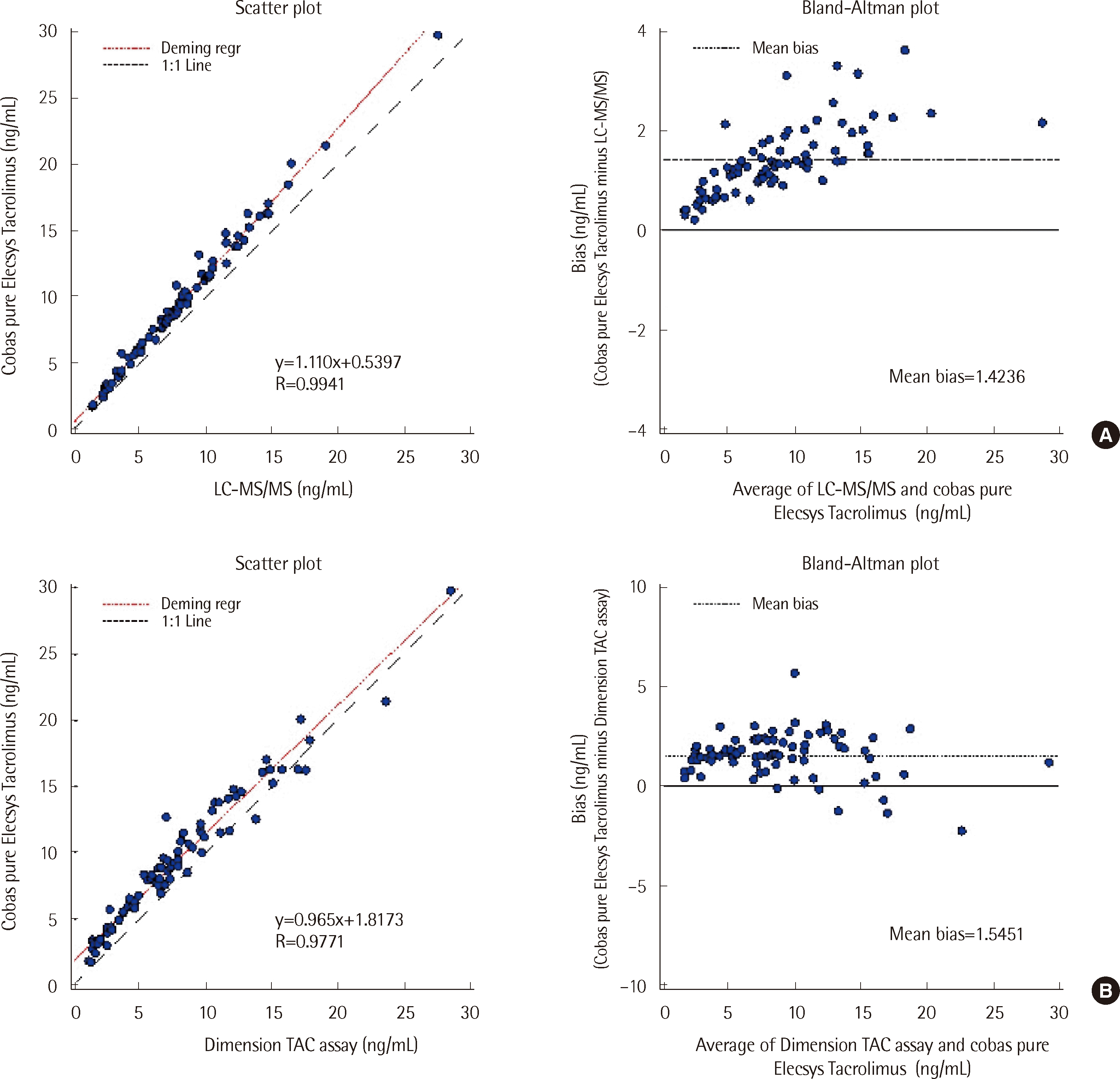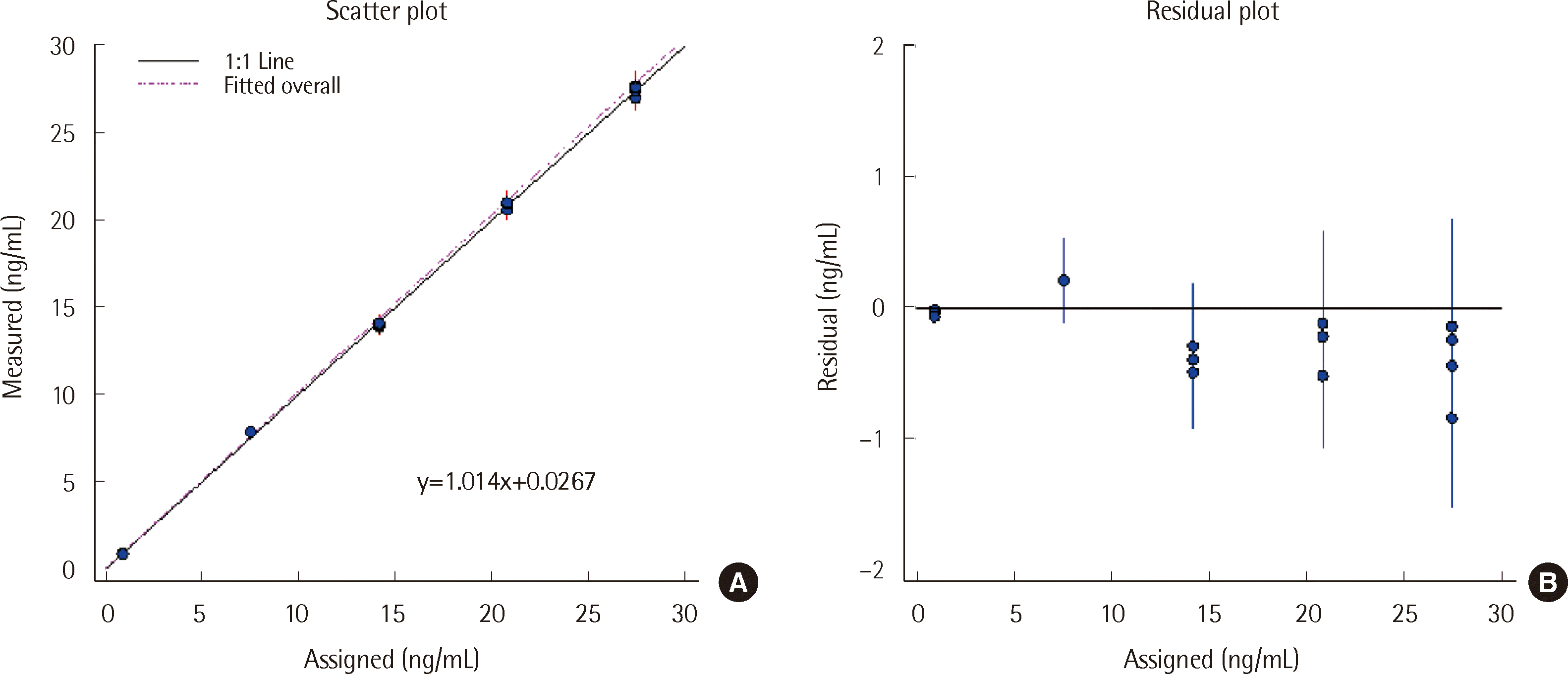1. Hatanaka H, Iwami M, Kino T, Goto T, Okuhara M. 1988; FR-900520 and FR-900523, novel immunosuppressants isolated from a Streptomyces. I. Taxonomy of the producing strain. J Antibiot (Tokyo). 41:1586–91. DOI:
10.7164/antibiotics.41.1586. PMID:
3198493.
2. Laskow DA, Neylan JF 3rd, Shapiro RS, Pirsch JD, Vergne-Marini PJ, Tomlanovich SJ. 1998; The role of tacrolimus in adult kidney transplantation: a review. Clin Transplant. 12:489–503.
3. Oellerich M, Armstrong VW, Schütz E, Shaw LM. 1998; Therapeutic drug monitoring of cyclosporine and tacrolimus. Update on Lake Louise Consensus Conference on cyclosporin and tacrolimus. Clin Biochem. 31:309–16. DOI:
10.1016/s0009-9120(98)00049-6.
4. Kalt DA. 2017; Tacrolimus: a review of laboratory detection methods and indications for use. Lab Med. 48:e62–5. DOI:
10.1093/labmed/lmx056. PMID:
29096030.
5. Taibon J, van Rooij M, Schmid R, Singh N, Albrecht E, Anne Wright J, et al. 2020; An isotope dilution LC-MS/MS based candidate reference method for the quantification of cyclosporine A, tacrolimus, sirolimus and everolimus in human whole blood. Clin Biochem. 82:73–84. DOI:
10.1016/j.clinbiochem.2019.11.006.
6. Qin X, Rui J, Xia Y, Mu H, Song SH, Raja Aziddin RE, et al. 2018; Multi-center performance evaluations of tacrolimus and cyclosporine electrochemiluminescence immunoassays in the Asia-Pacific region. Ann Lab Med. 38:85–94. DOI:
10.3343/alm.2018.38.2.85. PMID:
29214751. PMCID:
PMC5736684.
7. Clinical, Laboratory Standards Institute. 2014. Evaluation of precision of quantitative measurement procedures; Approved guideline—Third edition. Clinical and Laboratory Standards Institute;Wayne, PA: CLSI document EP05-A3.
8. Seger C, Shipkova M, Christians U, Billaud EM, Wang P, Holt DW, et al. 2016; Assuring the proper analytical performance of measurement procedures for immunosuppressive drug concentrations in clinical practice: recommendations of the International Association of Therapeutic Drug Monitoring and Clinical Toxicology Immunosuppressive Drug Scientific Committee. Ther Drug Monit. 38:170–89. DOI:
10.1097/ftd.0000000000000269.
9. Clinical, Laboratory Standards Institute. 2003. Evaluation of the linearity of quantitative measurement procedures: a statistical approach; Approved guideline. Clinical and Laboratory Standards Institute;Wayne, PA: CLSI document EP06-A.
10. Clinical, Laboratory Standards Institute. 2013. Measurement procedure comparison and bias estimation using patient samples; Approved guideline—Third edition. Clinical and Laboratory Standards Institute;Wayne, PA: CLSI document EP09-A3. DOI:
10.5040/9781526519986.chapter-013.
12. Lee EJ, Kim HK, Ahn S, Lee W, Kim HS, Chun S, et al. 2019; Accuracy evaluation of automated electrochemiluminescence immunoassay for everolimus and sirolimus compared to liquid chromatography-tandem mass spectrometry. J Clin Lab Anal. 33:e22941. DOI:
10.1002/jcla.22941. PMID:
31197901. PMCID:
PMC6757180.
13. Shipkova M, Vogeser M, Ramos PA, Verstraete AG, Orth M, Schneider C, et al. 2014; Multi-center analytical evaluation of a novel automated tacrolimus immunoassay. Clin Biochem. 47:1069–77. DOI:
10.1016/j.clinbiochem.2014.03.023. PMID:
24721684.
14. Cho EJ, Ko DH, Lee W, Chun S, Lee HK, Min WK. 2018; Performance of the Dimension TAC assay and comparison of multiple platforms for the measurement of tacrolimus. J Clin Lab Anal. 32:e22357. DOI:
10.1002/jcla.22357. PMID:
29148096. PMCID:
PMC6817031.
15. Wood WG. 1991; “Matrix effects” in immunoassays. Scand J Clin Lab Invest Suppl. 205:105–12.
16. Whicher JT. 1991; Calibration is the key to immunoassay but the ideal calibrator is unattainable. Scand J Clin Lab Invest Suppl. 205:21–32.
17. Güven E, Duus K, Lydolph MC, Jørgensen CS, Laursen I, Houen G. 2014; Non-specific binding in solid phase immunoassays for autoantibodies correlates with inflammation markers. J Immunol Methods. 403:26–36. DOI:
10.1016/j.jim.2013.11.014.
19. Hermida J, Tutor JC. 2009; Falsely increased blood tacrolimus concentrations using the ACMIA assay due to circulating endogenous antibodies in a liver transplant recipient: a tentative approach to obtaining reliable results. Ther Drug Monit. 31:269–72. DOI:
10.1097/ftd.0b013e31819c6d5c.
20. Rostaing L, Cointault O, Marquet P, Josse AG, Lavit M, Saint-Marcoux F, et al. 2010; Falsely elevated whole-blood tacrolimus concentrations in a kidney-transplant patient: potential hazards. Transpl Int. 23:227–30. DOI:
10.1111/j.1432-2277.2009.00965.x.
21. Kim H, Park H, Lee S, Chae H, Song SH, Lee Y, et al. 2021; Immunosuppressive drug measurement by liquid chromatography coupled to tandem mass spectrometry: interlaboratory comparison in the Korean clinical laboratories. Ann Lab Med. 41:268–76. DOI:
10.3343/alm.2021.41.3.268. PMID:
33303711. PMCID:
PMC7748092.
22. Gant Kanegusuku A, Yeo KJ. 2024; Is the automated Elecsys tacrolimus assay on the Roche cobas e 602 analyzer an acceptable replacement for a liquid chromatography-tandem mass spectrometry-based assay? Am J Clin Pathol. 161:97–106. DOI:
10.1093/ajcp/aqad114.
23. Iwasaki K. 2007; Metabolism of tacrolimus (FK506) and recent topics in clinical pharmacokinetics. Drug Metab Pharmacokinet. 22:328–35. DOI:
10.2133/dmpk.22.328.
24. Rigo-Bonnin R, Canalias F. 2019; Traceability of immunosuppressant’s mass concentration results obtained using different commercial calibrators. Clin Biochem. 63:113–20.





 PDF
PDF Citation
Citation Print
Print




 XML Download
XML Download